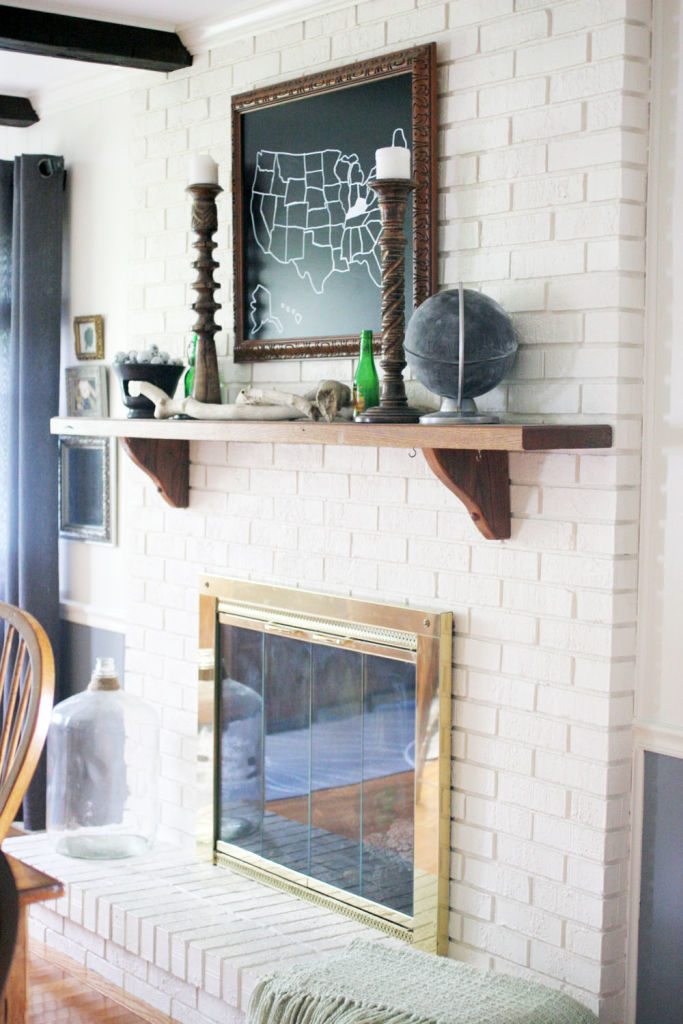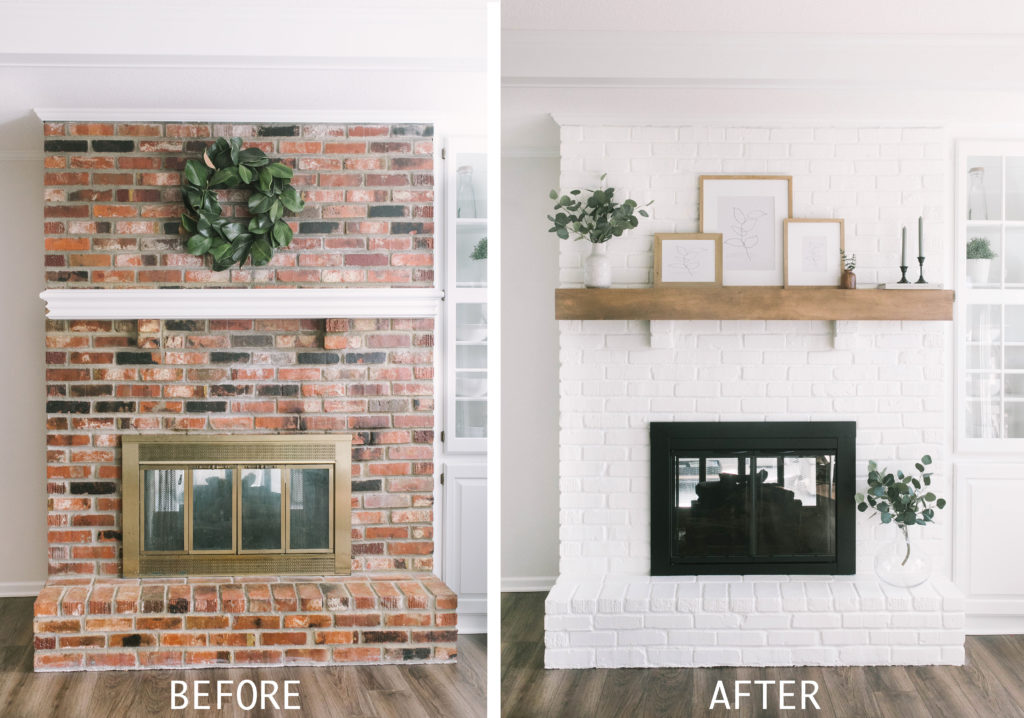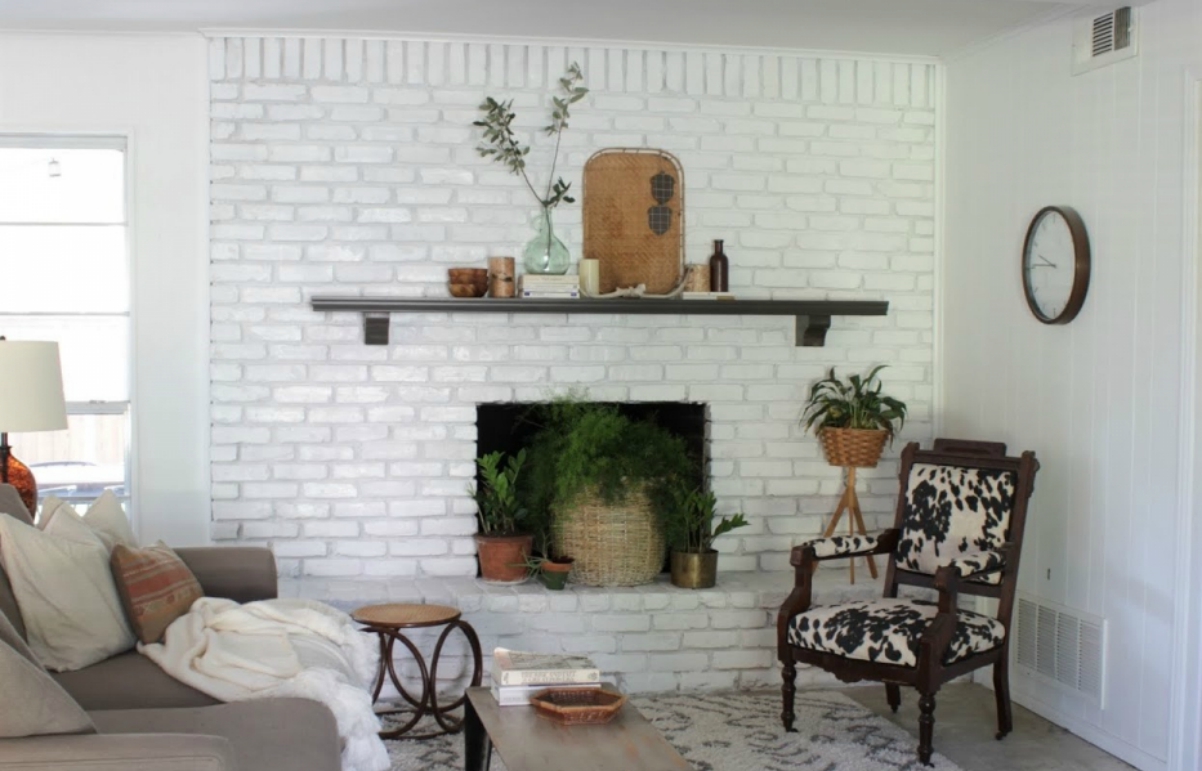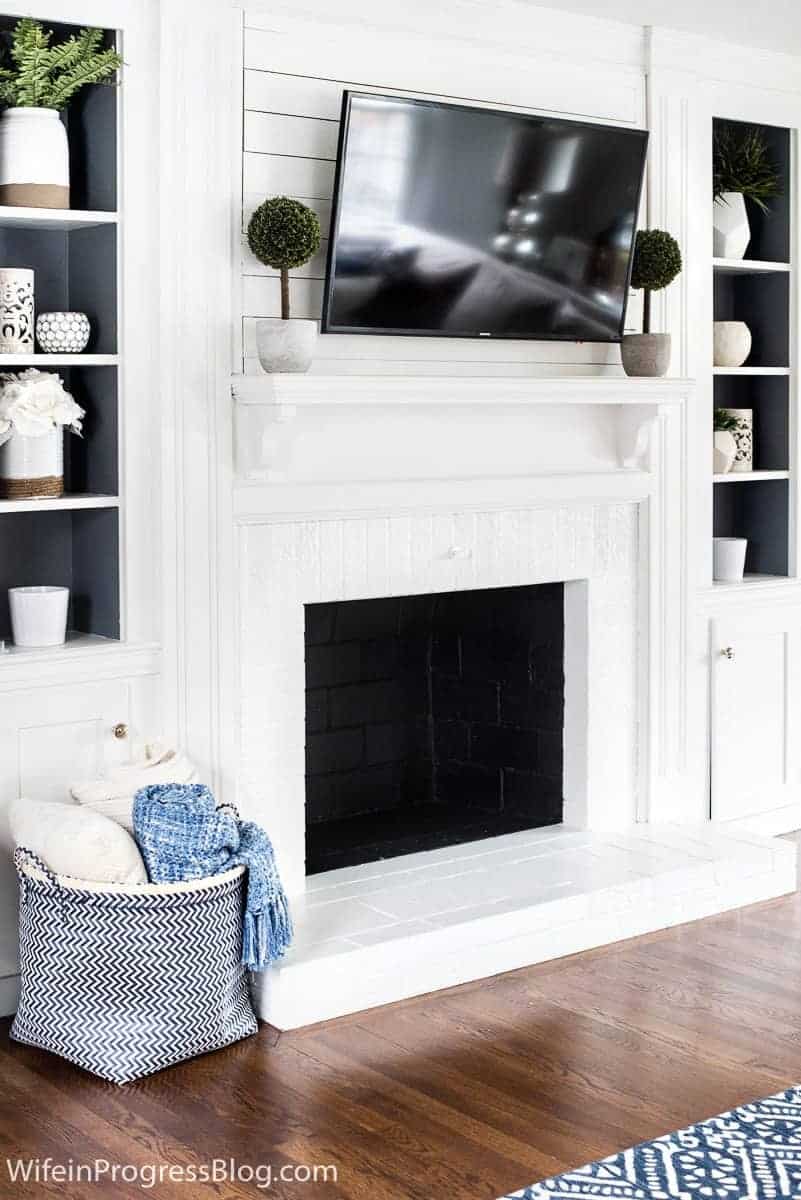Transforming a brick fireplace by painting it white is a popular and cost-effective DIY project that can breathe new life into your living space. Before starting the project, thorough preparation is essential. Begin by cleaning the brick surface to remove any dirt, soot, or residue. A mixture of trisodium phosphate (TSP) and water is an effective cleaning solution. Once cleaned, allow the brick to dry completely before moving forward. Assess the condition of the brick for any damages or cracks. Repair any imperfections with a suitable masonry filler, ensuring a smooth and even surface for the paint.
Images about DIY Paint Brick Fireplace White
DIY Paint Brick Fireplace White

Choosing the right paint is crucial for achieving the desired look and ensuring durability. Opt for a high-quality latex paint that is specially formulated for masonry surfaces. This type of paint provides excellent coverage and adhesion to porous surfaces like brick. Consider using a primer designed for masonry as well, as it helps the paint adhere better and ensures a more even finish. When selecting the shade of white, take into account the overall color scheme of the room and the desired level of contrast. Some homeowners prefer a bright, crisp white, while others opt for a softer, off-white hue.
The application process involves using a paintbrush for the mortar and hard-to-reach areas and a roller for the larger brick surfaces. Work in small sections to ensure even coverage and avoid visible brush or roller marks. It’s important to apply multiple thin coats rather than a single thick coat for a smoother and more professional finish. Allow each coat to dry thoroughly before applying the next. After completing the painting process, inspect the fireplace to ensure that the paint coverage is consistent, and touch up any areas that may need additional attention.
Maintaining a white-painted brick fireplace is relatively straightforward. Regular dusting with a soft cloth or a gentle brush helps keep the surface clean and free of dirt and debris. In the event of any stains or marks, a mild detergent and water solution can be used for spot cleaning. It’s important to avoid abrasive cleaning agents, as they can damage the paint finish. Periodic inspection of the painted surface for any signs of wear or chipping allows for timely touch-ups and ensures the longevity of the painted brick fireplace.
A DIY project to paint a brick fireplace white is an effective way to update and modernize the look of your living space. With proper preparation, the right materials, and meticulous application, you can achieve a clean and timeless aesthetic that complements your home’s style. The versatility of a white-painted brick fireplace allows it to seamlessly blend with various design schemes, making it a popular choice for homeowners seeking a budget-friendly and impactful transformation.
How to Paint a Brick Fireplace (and the Best Paint to Use
My Painted Brick Fireplace – DIY Tutorial
How to Paint Fireplace Brick White with Primer and Regular Paint
How to Paint a Brick Fireplace // DIY from Lovely Indeed
Paint Your Brick Fireplace Sutherlands Blog
Paint a Brick Fireplace
How to Paint A Brick Fireplace
DIY Tutorial: How to Paint a Brick Fireplace – Jenna Kate at Home
How to Paint a Brick Fireplace – Sarah Joy
Related Posts:
- Small Brick Fireplace
- Remodel Brick Fireplace With Stone
- Red Brick Outdoor Fireplace
- How To Clean Mold Off Brick Fireplace
- Painted Gray Brick Fireplace
- Paint Wash Brick Fireplace
- Victorian Brick Fireplace
- Old Brick Fireplace Remodel
- Update Old Brick Fireplace
- Old Brick Fireplace Makeover Ideas
DIY Paint Brick Fireplace White
A brick fireplace can be a stunning focal point in any room, but sometimes its traditional look may not fit with your desired aesthetic. If you’re looking to give your fireplace a fresh and modern update, painting it white can be an excellent choice. Not only does it brighten up the space, but it also creates a timeless and elegant look. In this detailed article, we will guide you through the process of DIY painting your brick fireplace white, providing step-by-step instructions, addressing common FAQs, and offering valuable tips for success.
Preparing the Fireplace:
Before embarking on your DIY painting project, proper preparation is crucial. Follow these steps to ensure a smooth and long-lasting finish on your brick fireplace:
Clean the Surface:
Begin by thoroughly cleaning the brick surface. Use a wire brush to remove any loose debris such as dust, soot, or cobwebs. Scrub gently to avoid damaging the bricks. You can also use a vacuum cleaner to remove any loose dirt or ash.
Remove Grease and Stains:
If your fireplace has accumulated grease or stains over time, it’s essential to remove them before painting. Mix warm water with mild dish soap and scrub the stained areas using a soft-bristle brush. Rinse with clean water and allow it to dry completely.
Patch Any Cracks or Holes:
Inspect the bricks for any cracks or holes that need repair. Use a high-quality masonry patching compound to fill in these imperfections. Smooth out the compound with a putty knife and let it dry according to the manufacturer’s instructions.
Can I paint a brick fireplace without cleaning it?
It is highly recommended to clean your brick fireplace thoroughly before painting it. Painting over dirt or debris will result in an uneven finish and decreased longevity of the paint.
Can I use any cleaning solution to remove stains from my brick fireplace?
It is best to use mild dish soap mixed with warm water for cleaning brick surfaces. Avoid using harsh chemicals or bleach, as they can damage the bricks.
Applying a Primer:
Applying a primer is a crucial step in ensuring proper adhesion and durability of the paint on your brick fireplace. Follow these steps for a successful priming process:
Select an appropriate primer:
Choose a high-quality latex-based primer suitable for masonry surfaces. Look for a primer that offers good adhesion and stain-blocking properties.
Protect the Surrounding Area:
Cover the floor and any surrounding surfaces with drop cloths or plastic sheets to prevent accidental paint splatters. Use painter’s tape to protect adjacent walls, mantels, or other areas you don’t want to be painted.
Apply the Primer:
Using a roller or brush, apply an even coat of primer on the entire brick surface. Apply a liberal amount of primer into the mortar joints as well, making sure to cover all crevices and creases. Allow the primer to dry completely according to the manufacturer’s instructions before proceeding.
Do I need to prime my brick fireplace before painting it?
Yes, applying a primer is essential when painting a brick fireplace. It helps seal the surface and ensures better adhesion of the paint, resulting in a more durable and long-lasting finish.
Can I skip the prim
Yes, you can paint directly on brick, but it is important to properly prepare the surface beforehand. Here are the steps to follow:
- Clean the brick: Use a wire brush or a power washer to remove any loose dirt, dust, or debris from the brick surface. Make sure the surface is completely clean and dry before proceeding.
- Repair any damages: Inspect the bricks for any cracks or holes. If you find any, use a mortar mix to fill them in and allow it to dry completely.
- Apply a primer: Brick is porous, so applying a primer will help create a smooth surface for the paint to adhere to and prevent it from being absorbed excessively. Use a high-quality masonry primer and follow the manufacturer’s instructions for application.
- Choose the appropriate paint: Select a high-quality masonry paint that is specifically formulated for exterior brick surfaces. Acrylic latex paints are commonly used for this purpose as they provide good adhesion and durability.
- Apply the paint: Use a roller or a brush to apply the paint evenly over the brick surface. Work in smaller sections at a time, and make sure to cover all areas thoroughly. For better results, apply multiple thin coats rather than one thick coat, allowing each coat to dry completely before applying the next.
Remember to consider weather conditions before painting, as extreme heat or cold can affect the drying process of the paint and its overall performance. Additionally, be sure to choose a color that complements the overall aesthetic of your home or desired look.
Always consult with professionals or follow manufacturer guidelines for specific instructions based on your project requirements.
It is not recommended to skip the priming step. Without a primer, the paint may not adhere properly to the brick surface, leading to an uneven finish and decreased longevity of the paint job
Priming is an essential step in the painting process, especially when it comes to painting brick surfaces. Here are a few reasons why it is not recommended to skip the priming step:
- Improved adhesion: Priming helps create a strong bond between the paint and the brick surface. Without a primer, the paint may not adhere properly, leading to peeling, chipping, or flaking over time.
- Even finish: Brick surfaces can be porous and uneven, which can affect the appearance of the paint job. Priming helps create a smooth and consistent surface, allowing for a more even and professional-looking finish.
- Increased durability: A primer acts as a protective barrier, preventing moisture from seeping into the brick and causing damage. It also helps prevent stains or discoloration from bleeding through the paint layer.
- Enhanced longevity: By promoting better adhesion and protection against moisture and other elements, priming can significantly increase the lifespan of your painted brick surface. Skipping this step may result in premature wear and deterioration of the paint job.
In summary, priming is crucial for achieving a long-lasting and high-quality paint job on brick surfaces. It ensures proper adhesion, improves the appearance of the finish, protects against damage, and increases durability. Therefore, it is not recommended to skip this important step.











